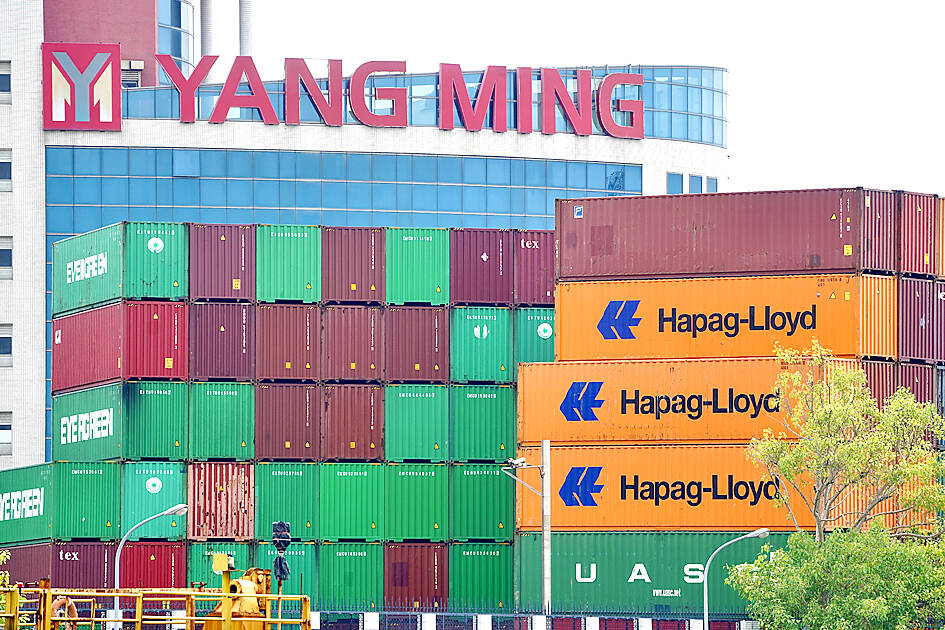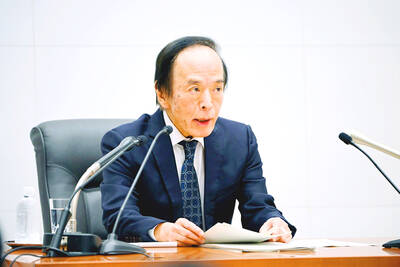Export orders last year increased 5.1 percent year-on-year to US$589.54 billion, ending two consecutive years of decline, the Ministry of Economic Affairs said in a report yesterday.
The growth in export orders beat the ministry’s forecast last month of an annual increase of 4.5 to 4.8 percent, with the size of orders hitting the third-highest level on record after US$674.13 billion in 2021 and US$666.79 billion in 2022, ministry data showed.
The increase came from strong demand for emerging technologies, such as artificial intelligence and high-performance computing, as well as rising orders for goods related to semiconductor equipment and some non-technology inventory restocking demand, the ministry said.

Photo: CNA
A low comparison base a year earlier also helped, it added.
The better-than-expected showing came as export orders — an indicator of product and component shipments to overseas markets for the following one to three months — last month increased 20.8 percent year-on-year to US$52.92 billion, rising for the 10th straight month and exceeding the ministry’s forecast of an increase of 13 to 17.5 percent.
In a poll of domestic manufacturers by the ministry, only 11.4 percent of respondents were optimistic that export orders would increase this month from last month, while 48.8 percent said that orders would be flat and 39.8 percent expected them to decline, the report said.
In addition, the diffusion index of export orders — a gauge of manufacturers’ expectations on export orders for the following month — fell to 42.4 last month from 48.8 in November and was below the threshold of 50, which suggests manufacturers are remaining cautious, it said.
As a result, export orders this month are forecast to decrease 4 to 8.1 percent year-on-year to between US$44.5 billion and US$46.5 billion, the ministry said.
The latest data showed that export orders last month for electronic components increased 33.5 percent year-on-year to US$19.92 billion, and those for information and communications technology (ICT) products grew 24.3 percent to US$15.25 billion.
Last year as a whole, orders for electronic components grew 11.5 percent year-on-year to US$211.55 billion, while ICT orders increased 3.6 percent to US$172.02 billion, the report said.
Orders for optoelectronic products increased 17.7 percent to US$1.89 billion last month and rose 8.7 percent to US$20.8 billion last year.
However, companies in non-technology sectors had a mixed showing last month, with export orders for machinery goods rising 6 percent, and those for plastic and rubber products increasing 5.5 percent year-on-year, while base metal and chemical products shrank 4.5 percent and 0.6 percent respectively, as firms lost orders amid price competition from foreign peers, the report said.
For the whole of last year, orders for machinery products increased 1.1 percent to US$19.43 billion; orders for base metal products edged up 0.3 percent to US$25.17 billion; orders for plastic and rubber products rose 1.7 percent to US$19.07 billion; and those for chemical goods were up 2.8 percent to US$17.91 billion, it said.
Throughout the year, the US, China and ASEAN were the three major export destinations, with orders from these markets rising 8.6 percent, 5.3 percent and 15.9 percent from the previous year to US$193.64 billion, US$126.68 billion and US$98.27 billion respectively.
Orders from the US last year registered the third-highest level on record, while those from ASEAN were the highest ever, ministry data showed.
Meanwhile, orders from Europe last year declined 9.9 percent year-on-year to US$84.62 billion and those from Japan fell 4.2 percent to US$29.22 billion, the report said.

Taiwan Semiconductor Manufacturing Co (TSMC, 台積電) last week recorded an increase in the number of shareholders to the highest in almost eight months, despite its share price falling 3.38 percent from the previous week, Taiwan Stock Exchange data released on Saturday showed. As of Friday, TSMC had 1.88 million shareholders, the most since the week of April 25 and an increase of 31,870 from the previous week, the data showed. The number of shareholders jumped despite a drop of NT$50 (US$1.59), or 3.38 percent, in TSMC’s share price from a week earlier to NT$1,430, as investors took profits from their earlier gains

In a high-security Shenzhen laboratory, Chinese scientists have built what Washington has spent years trying to prevent: a prototype of a machine capable of producing the cutting-edge semiconductor chips that power artificial intelligence (AI), smartphones and weapons central to Western military dominance, Reuters has learned. Completed early this year and undergoing testing, the prototype fills nearly an entire factory floor. It was built by a team of former engineers from Dutch semiconductor giant ASML who reverse-engineered the company’s extreme ultraviolet lithography (EUV) machines, according to two people with knowledge of the project. EUV machines sit at the heart of a technological Cold

TAIWAN VALUE CHAIN: Foxtron is to fully own Luxgen following the transaction and it plans to launch a new electric model, the Foxtron Bria, in Taiwan next year Yulon Motor Co (裕隆汽車) yesterday said that its board of directors approved the disposal of its electric vehicle (EV) unit, Luxgen Motor Co (納智捷汽車), to Foxtron Vehicle Technologies Co (鴻華先進) for NT$787.6 million (US$24.98 million). Foxtron, a half-half joint venture between Yulon affiliate Hua-Chuang Automobile Information Technical Center Co (華創車電) and Hon Hai Precision Industry Co (鴻海精密), expects to wrap up the deal in the first quarter of next year. Foxtron would fully own Luxgen following the transaction, including five car distributing companies, outlets and all employees. The deal is subject to the approval of the Fair Trade Commission, Foxtron said. “Foxtron will be

INFLATION CONSIDERATION: The BOJ governor said that it would ‘keep making appropriate decisions’ and would adjust depending on the economy and prices The Bank of Japan (BOJ) yesterday raised its benchmark interest rate to the highest in 30 years and said more increases are in the pipeline if conditions allow, in a sign of growing conviction that it can attain the stable inflation target it has pursued for more than a decade. Bank of Japan Governor Kazuo Ueda’s policy board increased the rate by 0.2 percentage points to 0.75 percent, in a unanimous decision, the bank said in a statement. The central bank cited the rising likelihood of its economic outlook being realized. The rate change was expected by all 50 economists surveyed by Bloomberg. The